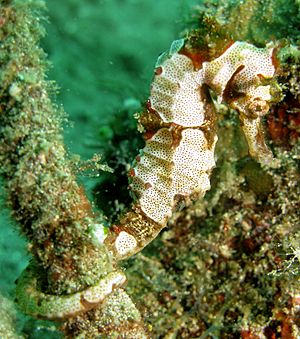Hedgehog seahorse facts for kids
Quick facts for kids Hedgehog seahorse |
|
|---|---|
 |
|
| Conservation status | |
| Scientific classification | |
| Synonyms | |
|
The hedgehog seahorse (Hippocampus spinosissimus) is a special type of fish. It belongs to the Syngnathidae family, which includes all seahorses and pipefishes. You can find this amazing creature in the warm coastal waters. Its home stretches from India and Sri Lanka to Taiwan and northern Australia.
Sadly, these unique seahorses are facing threats. The biggest problem is overfishing, which means too many are being caught. This happens both when they are specifically targeted and when they are accidentally caught in nets meant for other fish. Male hedgehog seahorses are quite special. They carry the eggs in a brood pouch on their belly. After the eggs develop, they give birth to live young.
Contents
What Does the Hedgehog Seahorse Look Like?
The hedgehog seahorse usually grows to be about 12.5 centimetres (4.9 in) long. It has a long snout and a small, low crown on its head called a coronet. Young seahorses have more spines on their bodies than adults.
Their colors can vary a lot! They often have a snout that is yellow-orange, deep red, or dark brown. The front of their head is usually dark. Their body and tail often have pale grey patches or stripes. Seahorses found in deeper water are usually red or orange. This helps them blend in with the sponges and corals that live at those depths.
Where Does the Hedgehog Seahorse Live?
Hedgehog seahorses live in reef areas. They prefer sandy or silty bottoms, not hard coral reefs. You can find them in waters up to 70 metres (230 ft) deep.
In places like the central Philippines, they are often found on soft, sandy areas. They like to hang out near octocorals, sea stars, sea pens, sea urchins, sponges, sunken wood, and seaweed. They are rarely found directly on hard reefs or among hard corals. Studies in Malaysia show they choose similar places to live.
Hedgehog Seahorse Habits
What Do Hedgehog Seahorses Eat?
This seahorse is a carnivore, meaning it eats other animals. It hunts for small crustaceans. These include tiny creatures like copepods, amphipods, and different kinds of small shrimps. They also eat other tiny planktonic invertebrates that float in the water.
Reproduction and Life Cycle
The hedgehog seahorse has a unique way of reproducing. The female uses a special tube called an ovipositor. She uses it to place her eggs into a closed pouch on the male's stomach. The male then fertilizes the eggs inside his pouch. He protects the developing baby seahorses. When they are ready, he gives birth to tiny, independent young. These newborns are only about 5.63 millimetres (0.222 in) long! Hedgehog seahorses become ready to have their own babies when they are around 10.4 centimetres (4.1 in) long.
How Many Hedgehog Seahorses Are There?
It's hard to know exactly how many hedgehog seahorses are in the ocean. However, studies on seahorse trade and surveys with fishers suggest their numbers have dropped. In the last 10 years, their population might have gone down by at least 30%. In some specific areas, the decline can be much worse. For example, in the central Philippines, their numbers dropped by 80% in just two months due to targeted fishing.
Why Are Hedgehog Seahorses in Danger?
The biggest danger to H. spinosissimus is overfishing. They are often caught by accident as bycatch in many fishing operations. This happens in countries like Cambodia, Malaysia, Thailand, the Philippines, and Vietnam. This species is one of the most commonly reported seahorses in trade. This shows how much pressure they face from being caught, especially as bycatch.
Protecting the Hedgehog Seahorse
All species of Hippocampus (the seahorse genus) are listed under Appendix II of the Convention on International Trade in Endangered Species of Wild Fauna and Flora. CITES is an international agreement that helps control the trade of endangered animals and plants. Countries that have signed CITES are supposed to issue permits for seahorse exports. They must also make sure that trading seahorses does not harm their wild populations.
However, this can be difficult because we often don't have enough information about seahorse populations. This makes it hard for authorities to know if their seahorse fishing is sustainable. The challenge is even bigger because most seahorses are caught as bycatch. This means that setting limits on exports doesn't always stop them from being caught.
Because of these challenges, it's very important to learn more about where and when seahorses live. This information can help us create special protected areas. These areas can then be most effective in helping seahorse populations survive and thrive.
See also
 In Spanish: Hippocampus spinosissimus para niños
In Spanish: Hippocampus spinosissimus para niños


